
At TCS Live in Ann Arbor, Red Wings coach Derek Lalonde explained the simple habits of a successful PP. Here's a look at the tactics he uses in Detroit and brought to May's World Championships with Team USA
At TCS Live in Ann Arbor, Red Wings coach Derek Lalonde explained the simple habits of a successful PP. Here's a look at the tactics he uses in Detroit and brought to May's World Championships with Team USA
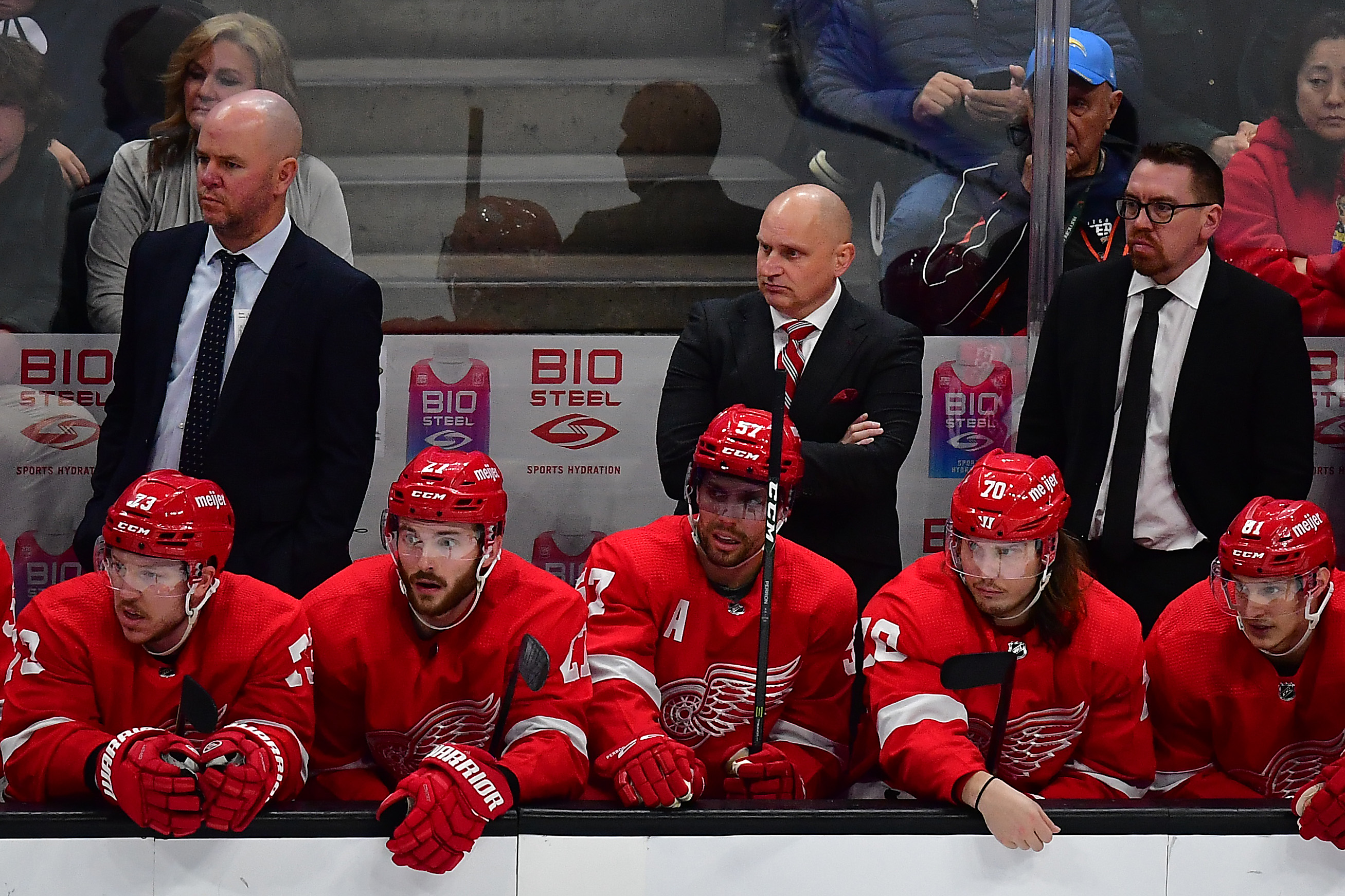
At The Coaches’ Site’s annual TCS Live conference in Ann Arbor late last month, Red Wings head coach Derek Lalonde delivered a talk entitled “The Simple Habits of an Effective Power Play.”
Lalonde noted that the principles he discussed in the presentation were the same ones he advocates with the Red Wings and that the clips he used to illustrate them were the exact ones he showed to Team USA at Men’s Worlds in May, for whom he ran the power play.
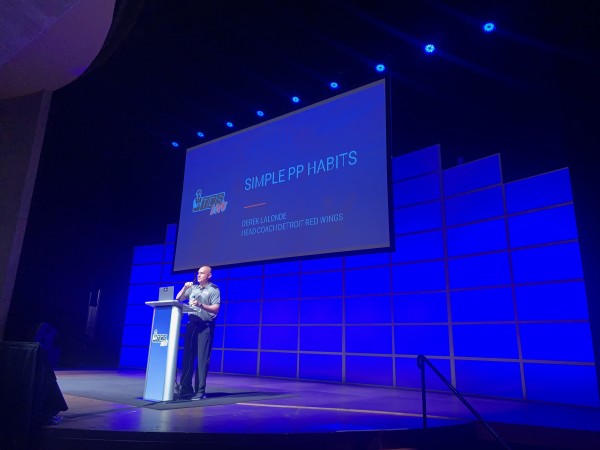
Before diving into the heart of his subject matter, Lalonde offered a challenge disguised as a word of warning. “First and foremost, the power play can be very complex and can be a little bit scary,” he said. “And sometimes people run from it. I can say that confidently because at times throughout my career, I did that. [I was the] PK guy in Tampa, [I’m] the head coach now, it's easy just to pass it off and go from there."
Lalonde credited assistants Alex Tanguay and Jay Varady for the work they did to help the Detroit power play jump from 26th to 17th in the NHL a year ago. Though he opened with that nicety, he would go on to point out with a sheepish grin that, even if Team Canada took gold at Worlds, the Canadian unit Tanguay oversaw converted far less often than Lalonde’s American power play (21.74% to 29.17%).
However, despite the challenge of running a power play unit, Lalonde pointed out to the coaches assembled before him that embracing that challenge can equip a young coach with a “tool” to “climb the ladder.” He cited Jeff Halpern and Brett McLean, two former colleagues, as examples.
Halpern embraced the power play as an assistant with the Syracuse Crunch (Tampa Bay’s AHL affiliate) and parlayed that expertise into a spot on Jon Cooper’s staff with the big club. He has since been mentioned in connection with several head coaching vacancies at the NHL level. Meanwhile, Lalonde hired McLean to his Iowa Wild staff because of McClean’s aptitude for the power play, a gig that McClean rode to a spot on the Minnesota bench before returning to Iowa last season as head man.
With that bit of encouragement as a prelude, Lalonde re-emphasizes his number one priority: simplicity. “I want it to be simple, very simple,” he says. “We have 18-year-old players on our power play, 19-year old players. And we’ve got NHL veterans that are 35-years-old.” Especially in the context of an international tournament, Lalonde doesn’t want or need tactical intricacy.
Instead, he cites three central priorities: face-off approach, breakout execution, and in-zone habits.
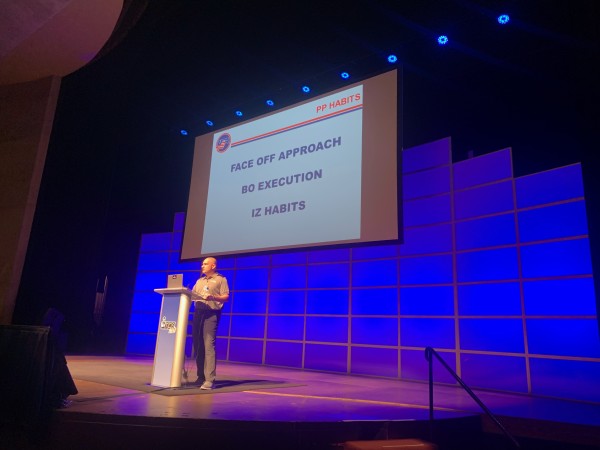
As for the first of these, Lalonde stresses that his team must be “face-off ready” at the drop of the puck. By this, he means he expects the team to be able to win control of the puck, even if they lose the face-off, because everyone except the center gets a quick jump on the drop to take control of each area the puck might end up. The center then “bulls” his opposition, preventing the opposing pivot from getting out to his defensive responsibility (in essence, a bit of legal interference).
Lalonde adds that face-offs are a key area where the staff’s pre-scout comes into play. Beyond being “face-off ready,” Lalonde wants his power play to have a plan to exploit the opponent’s tendencies off the draw.
On the subject of breakout execution, Lalonde refers to two “non-negotiables”: breaking out together and finishing routes (also together).
For the head coach, breaking out together is most important at the offensive blue line. The four players who don’t have the puck on a power play entry must “hit the line together” and do so with speed. This approach will force back the penalty killers and provide a bit of extra space for the puck carrier. From this position, Lalonde stresses that each player away from the puck “finishes their routes,” dispersing throughout the offensive zone to provide the puck carrier with options.
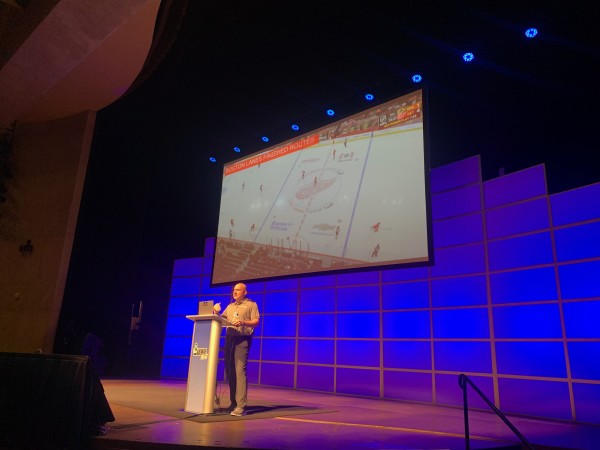
When it comes to in-zone habits, Lalonde names four chief priorities: a shot-first mentality, loose puck retrievals, bumper support, and getting the PK’s box moving.
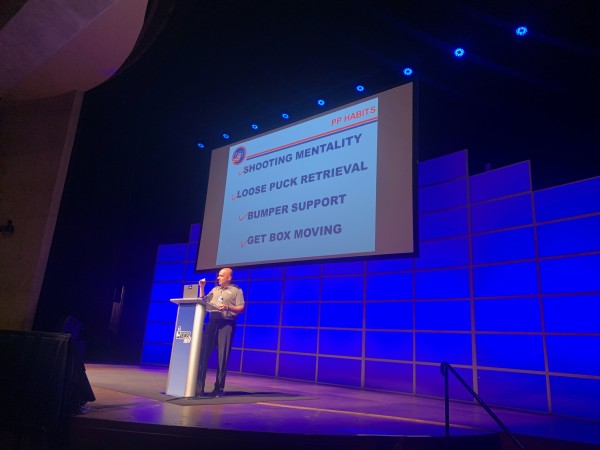
He notes that a shot is never a bad play, and that swarming to recover loose pucks is essential to sustaining possession.
He stresses the importance of the “bumper spot” at the center of a 1-3-1 power play (the formation favored across today’s NHL) as a tool to relieve pressure. When an opposing kill starts to collapse, the bumper player can slide in and provide close support and a readily available outlet.
He explains that he wants his team’s passing to force the opposing PK into a scramble (i.e. the box begins to move), with a priority on manipulating the feet of the PKers to put them into compromised positions and create space.
To make some of these concepts a bit more vivid, let’s take a look at four clips of our own, each a Red Wings power play goal from the 2022-23 season:
Clip #1: Dylan Larkin PPG, BOS @ DET, 3/12/23
[embed]https://www.youtube.com/watch?v=puFSV_8f0y4[/embed]
This PP begins with a great example of face-off readiness: Dylan Larkin pulls the draw to what should be a contested area, but his winger Alex Chiasson is the only player quick off the drop of the puck looking for it. The Wings take control and know that they will have space in high ice along the wall to get set up agains the Boston kill. Unfortunately for Detroit, Patrice Bergeron is on the ice for the Bruins. He does a deft job of eluding Larkin’s pick attempt and eventually forces a clearance.
At 35 seconds into the clip, you can see Moritz Seider leave a drop pass for Dylan Larkin. Seider’s next job, per Lalonde, is to pick F1 (the first forechecker) on the opposing PK. He doesn’t initiate some big collision (the kind of thing that might produce an interference call), but he makes Larkin a bit more room to gain the zone.
At 39 seconds, you can see all four Wings beside Larkin hitting the blue line together and doing so with momentum. Chiasson (to whom Larkin has dished the puck) rims around the boards to find David Perron (who has finished his route along the far half-wall).
The Wings create an initial chance from Lucas Raymond to Chiasson; it’s not a shot-first mentality, but it’s the next best thing—setting up a potential tap-in at the back post.
You can also detect some excellent subtle movement from Larkin in the bumper spot. He finds soft space in the slot to make sure he’s offering a passing option throughout the play. As Raymond can’t quite hit Chiasson, Larkin is providing Raymond with an alternate option.
Detroit wins the puck back despite being outnumbered on the recovery because Perron anticipates and halts the Bruin clearance attempt. As the puck works back over to Raymond, Larkin re-situates himself in a soft area in prime real estate in the slot. Once he takes Raymond’s feed, Larkin wires a lethal wrister. With help from a Chiasson screen, Detroit scores a massive goal to take a 3-0 lead.
Clip #2: Jonatan Berggren PPG, PIT @ DET, 3/28/23
[embed]https://www.youtube.com/watch?v=axMJm1U6e50[/embed]
Once again, Detroit takes control thanks to face-off readiness off a contested draw. The big key to the Wings’ success on the sequence is the way they “move the box” of the Penguin PK.
Note the relationship between the Pittsburgh killers throughout this clip. They are scrambling almost immediately and the distance between them is constantly growing and shrinking. In other words, there’s space to be exploited. If the Red Wings have an issue here, it’s a reluctance to get shots off. Still, Larkin offers another nice example of his movement and support from the bumper at the 29-second mark.
Eventually, the Red Wings are forced to reset deep in their own end with 25 seconds left in the power play. Normally, this isn’t a situation where you’d expect to see a quality PP chance. Detroit has changed, and it’s tempting to believe that the man advantage has functionally been killed already. Instead, Detroit executes a perfect breakout.
At 1:49, you can see the way Berggren breaks in with four Red Wings hitting the offensive blue line together and with speed. A beautiful passing sequence turns the aggressive Pittsburgh PK box into a mess once again. Berggren eventually finishes that sequence by just sneaking a first-time shot past Casey DeSmith with just one second left on the power play.
Clip #3: David Perron PPG, DET @ WPG, 3/31/23
[embed]https://www.youtube.com/watch?v=khPrcfQ2ucE[/embed]
This clip is all about one thing: shot-first mentality.
The power play opens off a brief 4-on-4 situation when Perron steps out of the box. At 34 seconds, we get one more example of all four Wings hitting the offensive blue line together and with pace. Lucas Raymond shoots the puck around the wall to Perron.
Perron clearly identifies that the Jets PK is reluctant to be over-exposed by Detroit’s puck movement. In other words, the box isn’t moving much, so Perron knows that he is going to have more time and space in high ice than he would against an aggressive PK like Pittsburgh’s.
Armed with this information, Perron embraces the shot-first mentality Lalonde described. He doesn’t have a great look, but he’s in the middle of the ice, and there’s traffic at the net. A shot couldn’t hurt, and Perron is rewarded for his decision when his innocuous-looking attempt banks off a defenseman and past Connor Hellebuyck for a goal.
Clip #4: Dominik Kubalik OT PPG, DET @ NYR, 11/6/22
[embed]https://www.youtube.com/watch?v=pqKXqMo1Ojg[/embed]
This power play comes in OT, so we’re dealing with a 4v3 instead of 5-on-4. Detroit applies some early pressure, but after about 20 seconds, the Rangers clear the zone. After the Wings re-enter, a Larkin pass misses its mark, and the puck drifts back into the Detroit zone.
Alex Nedeljkovic steps out from his crease to send an aggressive stretch pass to Kubalik at the offensive blue line. It’s an unconventional entry (barely onside after a review), but it illustrates one more key principle of Lalonde’s power play: “the entry box,” a term the coach uses to describe the space along the wall just inside the offensive blue line.
After gaining an entry, the puck carrier should show his back to the defenders and pull up in the entry box, which will give him the time and space he needs to send a pass to a teammate who has finished his route elsewhere in the zone.
Once the Wings get their formation set up, you can see another one of Lalonde’s points of emphasis: layering. Pause the video at about 58 seconds. If you drew horizontal lines from wall to wall across the offensive zone at the height of each Detroit attacker, you would have four different lines. This distribution disorients and spreads the PK.
With that spacing, Perron is able to deliver a crisp and incisive pass to Kubalik at the back post, and, after an offside review, the Red Wings claim an OT victory.
None of the schematics Lalonde outlines are complex. The idea isn't to put on a tactical masterclass to free up space with schematic brilliance. Instead, Lalonde preaches simple, easily identifiable habits to create subtle and replicable advantages on the man advantage.
